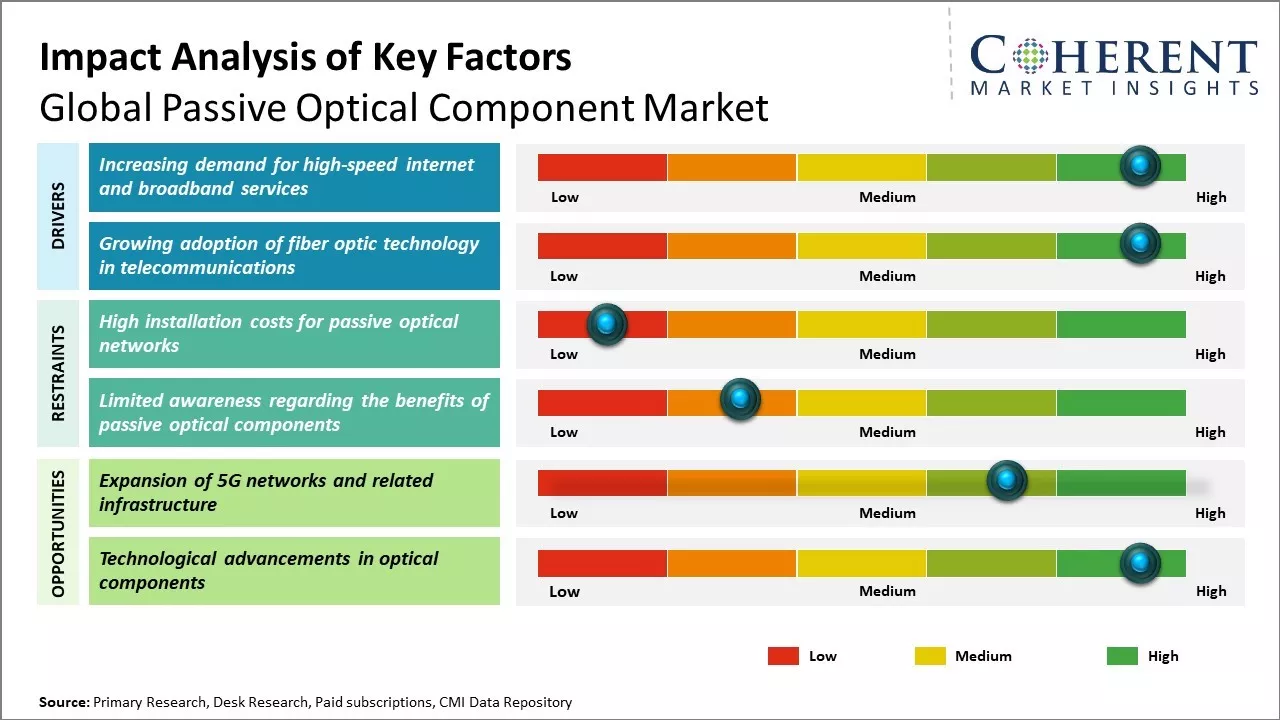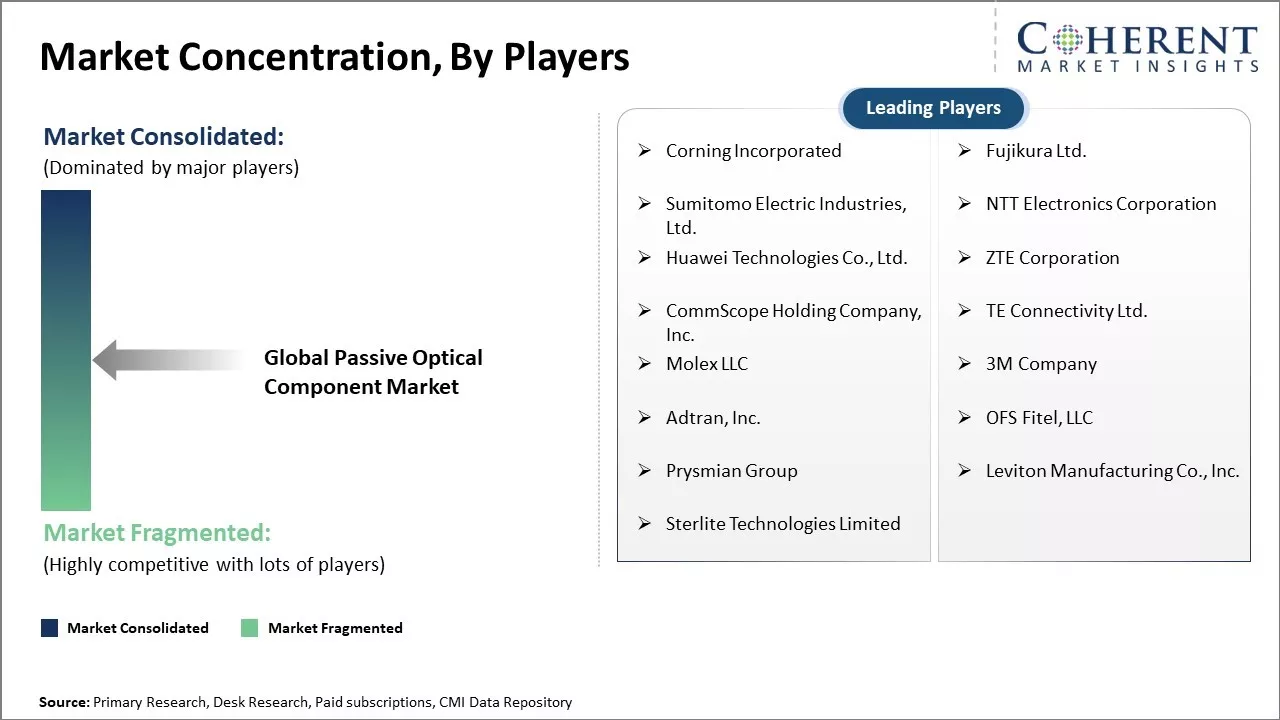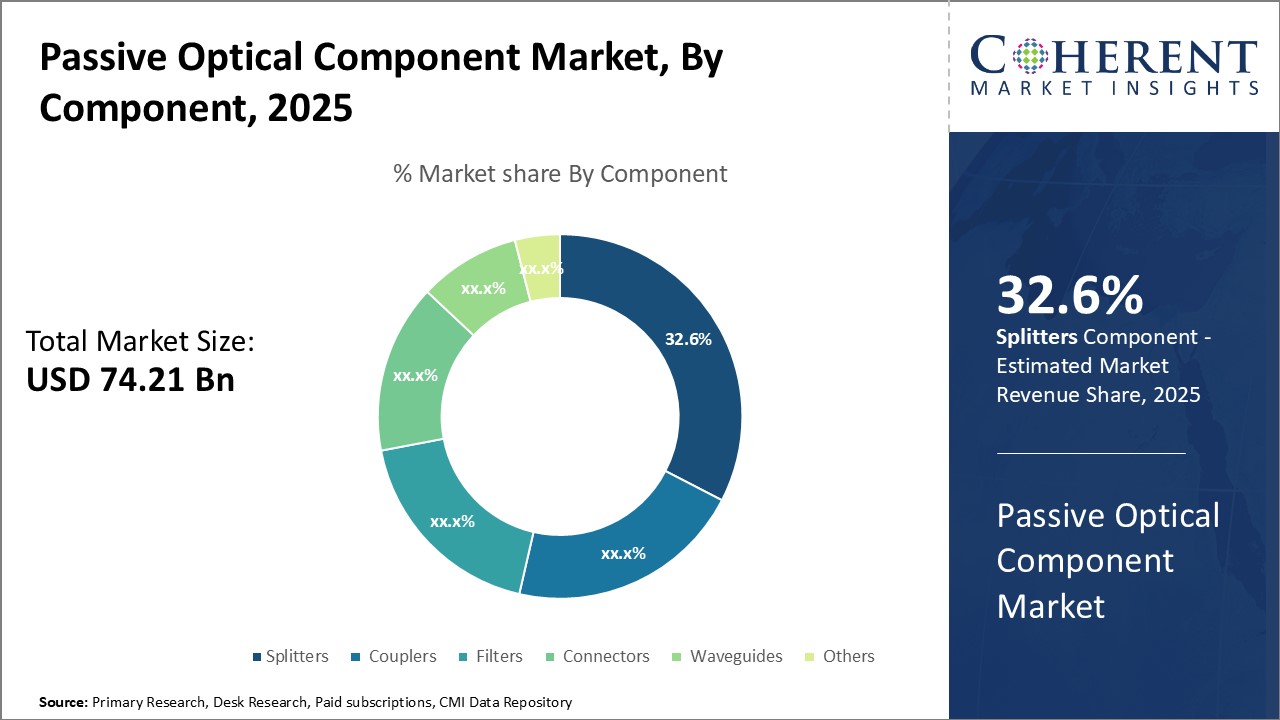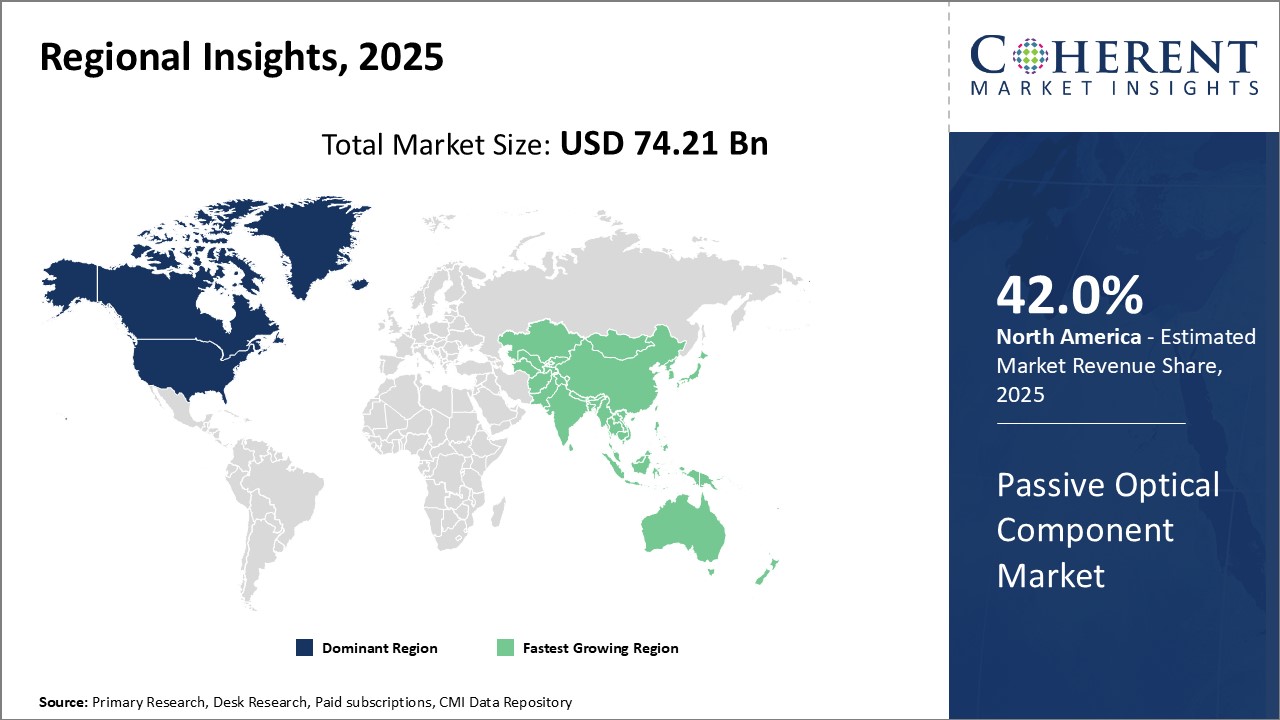
Global passive optical component market is estimated to be valued at US$ 74.21 Bn in 2025 and is expected to reach US$ 222.85 Bn by 2032, exhibiting a compound annual growth rate (CAGR) of 17.0% from 2025 to 2032.

Discover market dynamics shaping the industry: Download Free Sample
Global passive optical component market growth is driven by growing demand for fiber to the home connections and increased investments by telcos and data centre operators to enhance network infrastructure. There has been rising need for bandwidth due to increasing internet usage, 5G rollouts, and adoption of hybrid work models, and this boosts the need for network upgrades globally. Governments around the world are focusing on building smart cities, which require strong optical fiber networks to support deployments like connected vehicles, IoT sensors and others. The COVID-19 pandemic has boosted digital transformation and increased dependency on high-speed internet.
Market Driver - Increasing demand for high-speed internet and broadband services
Rising demand for high speed internet connections and broadband services can drive the market growth. With people getting more connected and relying on the internet for various activities like working from home, online education, video streaming, gaming and more, there has been huge need for fast and reliable internet connections. This widespread digital transformation fueled by the COVID-19 pandemic has pushed internet service providers to upgrade their infrastructure and offer higher internet speeds and bandwidth to consumers.
This has boosted demand for fiber optic cables and passive optical components that help deliver data at ultra-high speeds. Telecom operators are aggressively rolling out fiber to the home networks to support the insatiable hunger for bandwidth among users. This involves laying down optical fiber cables right up to people's homes and businesses to provide fiber to the premises directly. While these networks were being built in many developed nations like U.S., Japan, China, etc. before as well, the pandemic has accelerated fib erization projects globally as the need for high speed internet became apparent. With fiber networks promising bandwidths as high as 1 gbps symmetrically, consumers are readily adopting these services wherever available.
For instance, in August 2022, Huawei Technologies, a leading global provider of information and communications technology (ICT) solutions, partnered with several telecom operators to deploy advanced passive optical networks (PON). This partnership aims to enhance broadband connectivity and improve network performance across various regions. By leveraging Huawei's cutting-edge optical technologies, the partnership is expected to facilitate the rollout of high-speed internet services, supporting the growing demand for digital communication and connectivity in both urban and rural areas.

Get actionable strategies to beat competition: Download Free Sample
Growing adoption of fiber optic technology in telecommunications
Global telecommunications industry has been rapidly embracing fiber optic networks for deploying high speed broadband connectivity. Traditional copper based networks have limitations and cannot support the explosive data growth driven by newer technologies. Thus, companies around the world are heavily investing in modern all-optical fiber infrastructure. While countries in the developed world switched to fiber, even emerging markets in Asia, Latin America, Middle East and Africa are now prioritizing fiber optic deployments.
Next generation broadband technologies like 5G and fiber to the home require vast amounts of fiber to be laid both at the backbone and access network levels. 5G will allow internet speeds over 10Gbps but it depends on high fiberization wherein mobile towers are connected through optical fiber cables. Telecom operators are collaborating with utilities to lay micro-ducts and micro-cables alongside power cables to make fiber installation faster and more cost effective. Greenfield projects as well as upgrades of existing metro and long haul networks boosts need for transmission equipment, splitters, connectors and other passive optical components.
Key Takeaways from Analyst:
Global passive optical component market growth is driven by rapid expansion of telecommunication infrastructure to support increasing mobile data traffic. Ongoing 5G deployments necessitate fiberizations of telecom networks, thus, benefiting industry players. Rising need for high bandwidth and low latency networks among enterprises for applications like IoT and cloud computing can boost sales of passive optical components globally.
Lack of common interoperability standards may challenge the seamless proliferation of passive optical networks. Component suppliers may face issues regarding compatibility across different network equipment vendor platforms. Moreover, frequent technology shifts increase the risks of inventory obsolescence for component manufacturers.
Growing fiber to the home connections by internet service providers to offer high speed broadband can offer new growth opportunities. Increasing consumption of online videos, remote work culture can expand households demand for fiber network. Heavy investments by China in ultra-broadband networks can drive the Asia Pacific passive optical component market growth. Emergence of virtualized networks and network function virtualization also presents new avenues for component providers.
Market Challenge - High installation costs for passive optical networks
Global passive optical component market growth can be hampered due to high installation costs associated with setting up passive optical networks. Laying down fiber optic cables and installing other passive infrastructure requires extensive trenching works. This involves heavy earthmoving equipment and labor intensive work. Especially in developed economies where existing telecommunications lines and underground utility networks are highly congested, any new fiber laying requires careful planning and coordination between various stakeholders. This significantly drives up the costs of initial deployment and expansion of passive optical networks. High upfront capital expenditures pose a major deterrent for networking service providers to aggressively rollout fiber connections. Cost effective installation techniques and streamlined regulatory clearances can help address this challenge and promote faster adoption of fiber networks.
Market Opportunity: Expansion of 5G networks and related infrastructure
The rollout of 5G cellular networks around the world presents a massive opportunity for the global passive optical component market. 5G architecture relies on establishing a large number of compact cellular base stations or small cells which need to be densely deployed and connected with high bandwidth backhaul infrastructure. This provides an impetus for networking service providers to lay down more fiber optic cables and expand passive optical networks in order to carry exponentially higher data traffic from 5G. It is estimated that 5G deployment may require increasing the number of base station sites by 10 to 100 times compared to existing 4G networks. To support such dense small cell infrastructure, robust fiber connectivity comprising of various passive optical components such as optical cables, splitters and plug-in connectors will witness huge demand. As majority of countries have started rolling out their 5G roadmaps, it can boost revenue for passive optical component suppliers in the future.

Discover high revenue pocket segments and roadmap to it: Download Free Sample
Insights By Component - Splitters Segment Dominance Due to Exceptional Reliability
By component, splitters segment is estimated to contribute the highest market share of 32.6% in 2025, due to their exceptional reliability. Splitters seamlessly distribute light signals from a single optical fiber to multiple terminals with minimal loss of power or quality degradation over time. Their accurate splitting ratio ensures equitable access for all connected end points.
Advanced etching and bonding techniques have enabled splitters to withstand years of continuous high-bandwidth data flows without compromising performance. Even subtle vibrations or temperature fluctuations that may strain ordinary components leave splitter circuits unaffected. This reliable operation under real-world conditions is invaluable for telecom operators needing to guarantee uptime. Service providers also prefer passive splitters as their completely solid-state design obviates the periodic maintenance required by active components.
Splitters' ability to serve large port counts from a single trunk fiber can also drive the segment growth. By splitting a single stream into dozens of outputs, these optimize fiber usage and enable rapid scaling as demand grows for passive optical component. Their compact dimensions allow high port density fitting into restricted spaces. Furthermore, splitting losses remain consistent across all outputs, preventing interference that active components can experience at higher port counts. This scalable, efficient distribution of signals underscores splitters' indispensable role in contemporary networks.
For instance, In March 2021, Corning Incorporated, a leading provider of optical communication solutions, launched a new line of high-performance optical splitters designed specifically for data centers. These advanced optical splitters aim to enhance network efficiency and reliability, addressing the increasing demand for high-capacity data transmission in modern data center environments. By incorporating innovative technologies, Corning's new optical splitters are expected to support the growing need for effective monitoring and management of optical networks, further solidifying the company’s position in the optical communications market.
Insights By Material Type - Glass Segment Drives Growth by Solidifying Its Superiority
Among material type, glass segment is estimated to contribute the highest market share of 67% in 2025. Glass exhibits superior optical properties that makes it the preferred material for telecom applications. Its amorphous structure diffuses light uniformly without internal reflections, reducing signal loss. With a refractive index tightly tailored for optimal light transmission, glass produces minimal dispersion even over long transmission distances.
Glass excels at withstanding environmental pressures like temperature fluctuations, vibrations and humidity without compromising optical consistency. Its hermetic sealing against moisture ingress safeguards sensitive equipment against malfunctions. Chemically non-reactive, glass also avoids contaminations that degrade signal clarity. These rugged characteristics lengthen component lifespan, lowering long-term operating costs for network operators.
Processes like tube drawing yield glass fibers with near-perfect circularity over kilometers, a feat impossible with plastics. These dimensional uniformities are necessary to achieve the small core sizes and high core-cladding index differentials critical for high-speed transmission. Glass emerges as the ideal material for passive components requiring precision transmission in mission-critical networks.
Insights By Application - The Telecommunication Segment Leads as It Forms the Backbone of Digital Connectivity, Powering Economies Globally
By application, telecommunication segment is estimated to contribute the highest market share of 46.8% in 2025. Telecom networks form the foundation of digital connectivity, driving global economies. This infrastructure faces continuous traffic growth due to new users and bandwidth-intensive applications being constantly pushed to the edge.
Passive optical components play an essential role by scaling network transmission capacity economically. Technologies like GPON and NG-PON2 leverage passive splitters, filters and connectors to multiply fiber output at each node. This multiplies access points without adding active equipment costs proportionately. Such passive multiplication allows networks to scale bandwidth in a capital efficient manner ahead of demand.
Passive components enable optical line terminals, distribution hubs and fiber deployments critical for 5G backhaul and ultra-broadband access rolls. These contemporary networks leverage tiny, power efficient passive devices operating at high data rates. Passive components also find application in next-gen fiber to the home deployments essential for gigabit home broadband.
Telecommunication sector drives exponential traffic growth globally. As networks evolve passively to meet this challenge, there will be huge demand for reliable, scalable passive components at the infrastructure level. This cements telecommunication sector leadership in terms of passive optical components consumption.
In November 2023, Sumitomo Electric Industries, Ltd., a global leader in advanced materials and connectivity solutions, expanded its manufacturing facility to increase production capacity for optical components. This expansion is part of the company's strategy to meet the growing demand for high-performance optical technologies, which are essential for applications in telecommunications and data transmission. By enhancing its production capabilities, Sumitomo Electric aims to strengthen its position in the optical components market and support the ongoing advancements in communication infrastructure.

Need a Different Region or Segment? Download Free Sample
North America dominates the global passive optical component market with an estimated market share of 42.0% in 2025. This region is home to several leading optical equipment vendors as well as network service providers who have been investing heavily in fiber deployment. The developed telecommunication infrastructure and early adoption of FTTH networks have provided a strong impetus for growth of passive optical components. Early large scale rollouts of fiber networks by major providers such as Verizon and AT&T boosts demand. The presence of major equipment manufacturers such as Cisco, Corning and CommScope has led to a proliferation of advanced optical equipment and components, keeping region at the forefront of technology innovation.
Countries like China, India, Japan and South Korea are viewed as high potential growth destinations due to supportive government policies and initiatives centered around digital connectivity as well as smart city developments. In China, major investments have been channelized through initiatives like Broadband China to expedite fiber deployment across both urban and rural territories. This has created a massive need for passive optical components, which can increase with upcoming 5G deployments. Indian telecom market is going through a phase of network upgrades with fiberization of existing mobile towers being prioritized. Growing optical network requirements of countries in Southeast Asia opens new avenues for passive component vendors.
While North America commands higher prices for advanced components owing to their technology leadership, Asian markets offer attractive volumes and scope for export of cost-optimized designs. Growing indigenous production capabilities of China enables it to emerge as a strong exporter while also catering to huge domestic needs. Thriving optical equipment manufacturing clusters in China, Taiwan and India present ample opportunities for global as well as local component manufacturers to gain economies of scale and scope.
Passive Optical Component Market Report Coverage
| Report Coverage | Details | ||
|---|---|---|---|
| Base Year: | 2024 | Market Size in 2025: | USD 74.21 Bn |
| Historical Data for: | 2020 To 2024 | Forecast Period: | 2025 To 2032 |
| Forecast Period 2025 to 2032 CAGR: | 17.0% | 2032 Value Projection: | USD 222.85 Bn |
| Geographies covered: |
|
||
| Segments covered: |
|
||
| Companies covered: |
Corning Incorporated, Fujikura Ltd., Sumitomo Electric Industries, Ltd., NTT Electronics Corporation, Huawei Technologies Co., Ltd., ZTE Corporation, CommScope Holding Company, Inc., TE Connectivity Ltd., Molex LLC, 3M Company, Adtran, Inc., OFS Fitel, LLC, Prysmian Group, Leviton Manufacturing Co., Inc., and Sterlite Technologies Limited |
||
| Growth Drivers: |
|
||
| Restraints & Challenges: |
|
||
Uncover macros and micros vetted on 75+ parameters: Get instant access to report
Share
Share
About Author
Suraj Bhanudas Jagtap is a seasoned Senior Management Consultant with over 7 years of experience. He has served Fortune 500 companies and startups, helping clients with cross broader expansion and market entry access strategies. He has played significant role in offering strategic viewpoints and actionable insights for various client’s projects including demand analysis, and competitive analysis, identifying right channel partner among others.
Missing comfort of reading report in your local language? Find your preferred language :
Transform your Strategy with Exclusive Trending Reports :
Frequently Asked Questions
Joining thousands of companies around the world committed to making the Excellent Business Solutions.
View All Our Clients